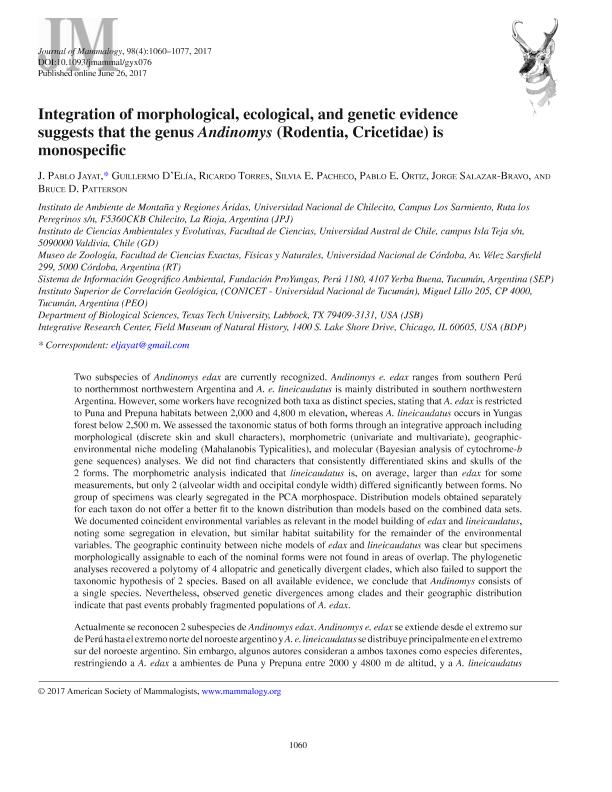Mostrar el registro sencillo del ítem
dc.contributor.author
Jayat, Jorge Pablo

dc.contributor.author
D' Elía, Guillermo
dc.contributor.author
Torres, Ricardo Marcelo

dc.contributor.author
Pacheco, Silvia Elena

dc.contributor.author
Ortiz, Pablo Edmundo

dc.contributor.author
Salazar Bravo, Jorge
dc.contributor.author
Patterson, Bruce

dc.date.available
2018-10-29T18:08:27Z
dc.date.issued
2017-06
dc.identifier.citation
Jayat, Jorge Pablo; D' Elía, Guillermo; Torres, Ricardo Marcelo; Pacheco, Silvia Elena; Ortiz, Pablo Edmundo; et al.; Integration of morphological, ecological, and genetic evidence suggests that the genus Andinomys (Rodentia, Cricetidae) is monospecific; Oxford University Press; Journal of Mammalogy; 98; 4; 6-2017; 1060-1077
dc.identifier.issn
0022-2372
dc.identifier.uri
http://hdl.handle.net/11336/63215
dc.description.abstract
Two subspecies of Andinomys edax are currently recognized. Andinomys e. edax ranges from southern Perú to northernmost northwestern Argentina and A. e. lineicaudatus is mainly distributed in southern northwestern Argentina. However, some workers have recognized both taxa as distinct species, stating that A. edax is restricted to Puna and Prepuna habitats between 2,000 and 4,800 m elevation, whereas A. lineicaudatus occurs in Yungas forest below 2,500 m. We assessed the taxonomic status of both forms through an integrative approach including morphological (discrete skin and skull characters), morphometric (univariate and multivariate), geographicenvironmental niche modeling (Mahalanobis Typicalities), and molecular (Bayesian analysis of cytochrome-b gene sequences) analyses. We did not find characters that consistently differentiated skins and skulls of the 2 forms. The morphometric analysis indicated that lineicaudatus is, on average, larger than edax for some measurements, but only 2 (alveolar width and occipital condyle width) differed significantly between forms. No group of specimens was clearly segregated in the PCA morphospace. Distribution models obtained separately for each taxon do not offer a better fit to the known distribution than models based on the combined data sets. We documented coincident environmental variables as relevant in the model building of edax and lineicaudatus, noting some segregation in elevation, but similar habitat suitability for the remainder of the environmental variables. The geographic continuity between niche models of edax and lineicaudatus was clear but specimens morphologically assignable to each of the nominal forms were not found in areas of overlap. The phylogenetic analyses recovered a polytomy of 4 allopatric and genetically divergent clades, which also failed to support the taxonomic hypothesis of 2 species. Based on all available evidence, we conclude that Andinomys consists of a single species. Nevertheless, observed genetic divergences among clades and their geographic distribution indicate that past events probably fragmented populations of A. edax. Actualmente se reconocen 2 subespecies de Andinomys edax. Andinomys e. edax se extiende desde el extremo sur de Perú hasta el extremo norte del noroeste argentino y A. e. lineicaudatus se distribuye principalmente en el extremo sur del noroeste argentino. Sin embargo, algunos autores consideran a ambos taxones como especies diferentes, restringiendo a A. edax a ambientes de Puna y Prepuna entre 2000 y 4800 m de altitud, y a A. lineicaudatus.
dc.format
application/pdf
dc.language.iso
eng
dc.publisher
Oxford University Press

dc.rights
info:eu-repo/semantics/openAccess
dc.rights.uri
https://creativecommons.org/licenses/by-nc-sa/2.5/ar/
dc.subject
Andean Rat
dc.subject
Central Andes
dc.subject
Muridae
dc.subject
Sigmodontinae
dc.subject
South America
dc.subject
Species Limits
dc.subject
Type Locality
dc.subject.classification
Otras Ciencias Biológicas

dc.subject.classification
Ciencias Biológicas

dc.subject.classification
CIENCIAS NATURALES Y EXACTAS

dc.title
Integration of morphological, ecological, and genetic evidence suggests that the genus Andinomys (Rodentia, Cricetidae) is monospecific
dc.type
info:eu-repo/semantics/article
dc.type
info:ar-repo/semantics/artículo
dc.type
info:eu-repo/semantics/publishedVersion
dc.date.updated
2018-10-23T18:18:43Z
dc.journal.volume
98
dc.journal.number
4
dc.journal.pagination
1060-1077
dc.journal.pais
Reino Unido

dc.journal.ciudad
Oxford
dc.description.fil
Fil: Jayat, Jorge Pablo. Universidad Nacional de Chilecito; Argentina. Consejo Nacional de Investigaciones Científicas y Técnicas; Argentina
dc.description.fil
Fil: D' Elía, Guillermo. Universidad Austral de Chile; Chile
dc.description.fil
Fil: Torres, Ricardo Marcelo. Universidad Nacional de Córdoba. Facultad de Ciencias Exactas, Físicas y Naturales. Museo de Zoología; Argentina
dc.description.fil
Fil: Pacheco, Silvia Elena. Fundación ProYungas; Argentina. Consejo Nacional de Investigaciones Científicas y Técnicas; Argentina
dc.description.fil
Fil: Ortiz, Pablo Edmundo. Consejo Nacional de Investigaciones Científicas y Técnicas. Centro Científico Tecnológico Conicet - Tucumán. Instituto Superior de Correlación Geológica. Universidad Nacional de Tucumán. Facultad de Ciencias Naturales e Instituto Miguel Lillo. Departamento de Geología. Cátedra Geología Estructural. Instituto Superior de Correlación Geológica; Argentina
dc.description.fil
Fil: Salazar Bravo, Jorge. Texas Tech University; Estados Unidos
dc.description.fil
Fil: Patterson, Bruce. Field Museum of National History; Estados Unidos
dc.journal.title
Journal of Mammalogy

dc.relation.alternativeid
info:eu-repo/semantics/altIdentifier/url/https://academic.oup.com/jmammal/article-lookup/doi/10.1093/jmammal/gyx076
dc.relation.alternativeid
info:eu-repo/semantics/altIdentifier/doi/https://dx.doi.org/10.1093/jmammal/gyx076
Archivos asociados
